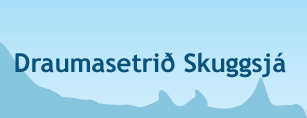Icelandic Institute for Dream Studies
Skuggsjá Dream Center
The Icelandic Institute for Dream Studies - Skuggsjá Dream Center was established in 2003, (skuggsjá being an old Icelandic word meaning mirror), and is located in the town of Akureyri in Eyjafjord, North East Iceland, www.akureyri.is, and has a secondary base at Hvanneyri, Borgarfjordur, in the Westland. Skuggsjá conducts research (qualitative and quantitative) into the Icelandic dream tradition in culture and folklore and cooperates with international organizations on dreams and dreaming. A museum of dreams and ideas. Skuggsjá is owned and run by dr. Björg Bjarnadóttir and her family in Iceland, UK, and Canada. Björg gained her Ph.D. in Developmental psychology from Stirling University in Scotland in 1996 with an emphasis in Psycholinguistics. Over the years, she has worked extensively in the field of child development and adult mental health in Iceland and lectured and supervised at the university level.
From the very first settlement of Iceland to present time, dreams abound in the sagas, literature, folklore, biographies, letters, articles, books and folk science. Even the history of philosophy and psychology in Iceland as academic subjects is closely linked to the study of dreams as one of the first psychological research ever conducted in Iceland centered on precognitive dreams and was published in 1915. For decades, books on dreams and dream interpretation, and on spiritual beliefs and narratives of psychic phenomena, have constantly been published and widely read by the population.
One of Skuggsjá’s main projects is based on a Gallup survey of over 40 questions into sleep and dreams and spiritual beliefs among modern day Icelanders. This survey was designed by Skuggsjá and rang out by Gallup in early Spring 2003. The sample consisted of 1200 people aged 18 to 85 with responding accumulating to a fair 67.5%. The results show that 72% of the population believes dreams to have some meaning for them in their daily lives. Furthermore, present day Icelanders know all the basic categories of dreams; reframing/restructuring dreams, recurrent dreams, nightmares, lucid dreams and daydreams, creative dreams, precognitive dreams, and dream visions. Over 50% experience lucid dreams often or sometimes and over 40% have themselves experienced precognitive dreams and over 70% believe such dreams do exist. These high figures of belief in and experience of precognitive dreaming confirm an earlier research of 1978 conducted by psychology professor Erlendur Haraldsson.
The Gallup survey looked into the issue of sleep among modern day Icelanders. Sleep patterns are rather healthy, the majority sleeps 7-8 hours a night and reports good sleep quality. Dream recall, dream interpretation and dream themes were also probed. Over 50% recall a dream at least once a week, the majority dreams in color and has dreams of both sexes, many report their dreams to friends and family and/or seek advice from dream interpretation books. The main dream themes being objects such as houses, places, people; activities such as traveling, doing something likeable, being with others, arguing; positive and negative emotions equally reported. Spiritual beliefs were probed for such as in life after death (66% and a further 10% neither/nor), in the power of prayer (66% and a further 10% neither/nor), and in psychic abilities (76%).
Other projects of Skuggsjá include publications of research materials such as the Dreamland book of 2003 in which results from the Gallup survey are presented together with samples of dreams from older accounts and from the present population. Poster exhibitions have been a substantial part of the center’s work over the years in which a mixture of text and picture is presented covering aspects of scientific and cultural dream materials. The exhibitions have been presented at Icelandic and international conferences and talks given such as at the Nordic psychiatric conference in Reykjavík in 2003, the International Congress of Psychology (ICP) in Bejing in 2004 and the annual dream conference in Copenhagen for the International Association for the Study of Dreams (IASD) in 2004, in Montréal in 2008, and for Stirling unviversity´s Dementia Services Development Centre (DSDC) at York in 2009. More recently, a presentation for IASD at Rolduc in Holland 2011, and Dream Yoga Research in Kashi India, (aka Varanasi aka Banares), in 2012. New or modified exhibitions have been presented annually in Akureyri and/or Djupivogur. A recent addition is a documentary film of 2006 into the Icelandic dream heritage - DreamReality. And a travelogue on Kashi, the eternal city of light aka Varansi, India, was published in November 2014 by Partridge/Penguin. It´s name: TRANSFER in Kashi and the River of Time; the book can be ordered from Amazon or Waterstones or some of the main webstores. Presently, work is in progress on a new travelogue on the mystic and dreaming nature of Iceland: Message from a Glacier, hopefully to be published in near future. In 2019, an ongoing cross-cultural study was launched into the dream heritage of other island and seafaring nations like Indonesia and Iceland with emphasis on precognition of changes in nature such as precognitive dreams of earthquakes and volcanic eruptions. Korean dream-culture past and present on the agenda, Korean films and music.
Recently, a comparative study into the dreams of Western Icelanders in Canada is being set up. There is an ongoing research into dreams in Icelandic culture and folklore aimed for publication in English. Work is now being put into guiding professionals and laymen alike into the Icelandic dream landscape, literally and figuratively speaking. One such visit took place in Summer 2006 under the guidance of former IASD president Robert Bosnak (cf. his widely translated book A little course in dreams). Fourteen experts on dreams made their visit to learn about the Icelandic dream tradition and the mystic landscape of Nature in South Iceland – of Ice and Fire - where many interesting dreams have been reported throughout the ages. Among which are precognitive dreams of upcoming catastrophes in nature such as earthquakes and volcanic eruptions. In Spring 2008, Robert again visited Iceland with his coworkers and fellow dreamers from the Cyberdreamwork organisation. This time the rich dream heritage of Eyjafjordur in the North East region was explored and visits made to the beautiful and mysterious Lake Myvatn.
See photos from the dream group''s visit at www.cyberdreamwork.com
http://www.cyberdreamwork.com/traveledio.html
In sum, the Gallup study and Skuggsjá''s sampling of dreams past and present confirms earlier research and ideas of dreams and beliefs into those in Icelandic culture. The younger generation seems to keep to their dreams as does the older one, an astonishing find in the face of a grossly changed world picture and ways of living.
Icelanders always were and still are great dreamers!
For further information, contact Skuggsjá Dream Center
dr. B. Bjarnadóttir at Fjólugata 8, 600 Akureyri
tel. +354 461 5311
|

